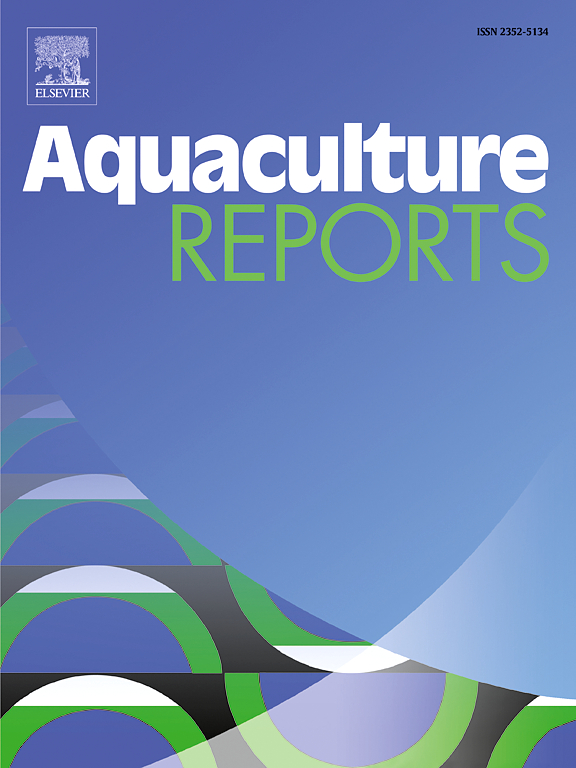Effects of dietary sodium alginate and Lactobacillus reuteri on the growth, antioxidant capacity and intestinal health of largemouth bass (Micropterus salmoides)
IF 3.2
2区 农林科学
Q1 FISHERIES
引用次数: 0
Abstract
Functional polysaccharides and probiotics are recognized for their ability to increase the growth and health of fish, but research on the combined impacts of these two compounds on aquatic organisms is limited. Hence, the aim of this study was to investigate the effects of single or complex sodium alginate and Lactobacillus reuteri on the growth, antioxidant status, immune function and intestinal health of largemouth bass (Micropterus salmoides). Four diets, CT for the control, SA for low molecular weight sodium alginate (10 g/kg), LR for L. reuteri (108 CFU/g), and ALR for SA+LR, were used to feed the fish (initial body weight of 4.68 ± 0.03 g) for 60 days. Our results revealed that the fish feed conversion rates and viscerosomatic indices of the SA and ALR groups were significantly lower than those of the CT group; the SA, LR and ALR groups presented significantly greater whole-fish crude protein and protein efficiency, and the highest values were found in the LR and ALR groups. Compared with those in the CT group, the aminotransferase activity and blood lipid levels of fish in the LR and ALR groups decreased, liver antioxidant enzyme CAT level was increased, and the MDA level decreased. In addition, the LR and ALR groups presented significant increases in muscular thickness and villus height and improved immune status by increasing intestinal barrier integrity and decreasing proinflammatory cytokine expression. For the intestinal microbiota, the dietary LR and ALR groups presented increased abundances of Firmicutes and Lactobacillus. The abundances of Fusobacteria and Cetobacterium increased in the SA group. In summary, SA and LR promote intestinal health by increasing the antioxidant capacity, improving the abundance of beneficial intestinal flora, and decreasing the levels of intestinal proinflammatory factors, which ultimately promote the growth of largemouth bass.
饲料中添加海藻酸钠和罗伊氏乳杆菌对大口黑鲈生长、抗氧化能力和肠道健康的影响
功能性多糖和益生菌被认为能够提高鱼类的生长和健康水平,但有关这两种化合物对水生生物的综合影响的研究却很有限。因此,本研究旨在调查单一或复合海藻酸钠和吕氏乳杆菌对大口鲈鱼(Micropterus salmoides)的生长、抗氧化状态、免疫功能和肠道健康的影响。研究人员使用四种日粮喂养大口鲈鱼(初始体重为 4.68 ± 0.03 克)60 天,其中 CT 为对照组日粮,SA 为低分子量海藻酸钠日粮(10 克/千克),LR 为重养乳杆菌日粮(108 CFU/克),ALR 为 SA+LR 日粮。结果显示,SA组和ALR组的饲料转化率和粘液质指数明显低于CT组;SA组、LR组和ALR组的全鱼粗蛋白和蛋白效率明显高于CT组,其中LR组和ALR组的全鱼粗蛋白和蛋白效率值最高。与 CT 组相比,LR 组和 ALR 组鱼的转氨酶活性和血脂水平降低,肝脏抗氧化酶 CAT 水平升高,MDA 水平降低。此外,LR 组和 ALR 组的肌肉厚度和绒毛高度显著增加,并且通过增加肠道屏障的完整性和减少促炎细胞因子的表达改善了免疫状况。在肠道微生物群方面,膳食 LR 组和 ALR 组的固缩菌和乳酸杆菌丰度增加。在 SA 组中,镰刀菌和鲸杆菌的数量有所增加。总之,SA 和 LR 可通过提高抗氧化能力、改善肠道有益菌群的丰度和降低肠道促炎因子水平来促进肠道健康,最终促进大口鲈鱼的生长。
本文章由计算机程序翻译,如有差异,请以英文原文为准。
求助全文
约1分钟内获得全文
求助全文
来源期刊

Aquaculture Reports
Agricultural and Biological Sciences-Animal Science and Zoology
CiteScore
5.90
自引率
8.10%
发文量
469
审稿时长
77 days
期刊介绍:
Aquaculture Reports will publish original research papers and reviews documenting outstanding science with a regional context and focus, answering the need for high quality information on novel species, systems and regions in emerging areas of aquaculture research and development, such as integrated multi-trophic aquaculture, urban aquaculture, ornamental, unfed aquaculture, offshore aquaculture and others. Papers having industry research as priority and encompassing product development research or current industry practice are encouraged.
 求助内容:
求助内容: 应助结果提醒方式:
应助结果提醒方式:


